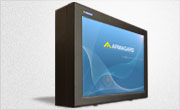Mounting Outdoor Digital Signs
Posted by: Richard Williams | Posted on: | 1 Comments
Visibility for an outdoor sign is perhaps even more important than the content being displayed on it. If the sign is not visible enough it will get unnoticed and there is little difference in the mounting of digital signage as to other forms of outdoor advertisements.
There is always a compromise in mounting outdoor signage – whether digital screens or conventional signs – as no outdoor advertisement can be in a position where it can cause a nuisance or an obstacle to commuters (including the disabled, elderly and moms with prams).
But most importantly any outdoor screen has to be noticeable and be aimed at the oncoming eye-line at the right viewing angle.
There are basically three options for mounting an outdoor TV:
- Floor mounted
- Wall mounted
- Ceiling mounted
Floor Mounting Outdoor Digital Signs
Perhaps the best solution for visibility; a floor mounted screen can either be a free standing unit or mounted on floor poles. Floor standing digital signage can become an obstacle though which for visibility is a good thing (you can’t miss what a sign is displaying if you have to walk around it) but equally can be a nuisance to pedestrians.
Ceiling Mounting Outdoor Digital Signs
Ceiling mounted digital signage take up less space and are preferred by many installers. There is often a shortage of ceiling space in outdoor locations, although they are commonly mounted under awnings and other bridge like structures. The big disadvantage of mounting a screen in this way is that the viewing angle has to be correct otherwise it can unnoticeable – especially if it is mounted too high as people will walk directly under it.
Wall Mounting Outdoor Digital Signs
There are various options for wall mounting a digital display. The first is the basic digital poster that lays flat against the wall. While this takes up less space than any other mounting option it is also less visible – especially as the viewing angle for modern LCD TVs is fairly narrow meaning the content won’t be viewable until the audience is very close to the sign.
The second option is to place the device on a bracket so it overhangs; in essence in a similar position to a ceiling mounted screen – only bolted to a wall. While this method ensures the screen is out of the way it is important to get the angle of the screen right as it can be all too easy to miss the sign and walk underneath without noticing it.
The third option for wall mounting is to use an elbow or perpendicular sign where the screen juts out at a right angle from the wall. For double-sided displays this is a real boon because both sides will be prominent and hard to miss – especially if it is not too high.
Post shortlink:
Popular Products
LCD Enclosure
Need armor for your LCD/LED screen(s)? Outdoors or inside the versatile LCD enclosure protects against thieves, vandals & the weather. Installation idea: NFL stadiums.
Outdoor Digital Signage
Exclusive 46” outdoor screen protection. Dubbed the ‘Totem’, due to its distinct design, it repels damage threats, but attracts audiences. Installation idea: Drive-thru restaurants.
Portrait Flat Panel Enclosure
Safeguard your eye-level advertising display screen(s), indoors or outdoors. Completely customizable, add exciting features like touch screen technology. Installation idea: Restaurant frontages.
Indoor Digital Signage
Popular purchase for retail outlets! Great for ‘point of sale’ persuasion, boost your brand with static & motion advertising from a single unit! Installation idea: Mall of America.





